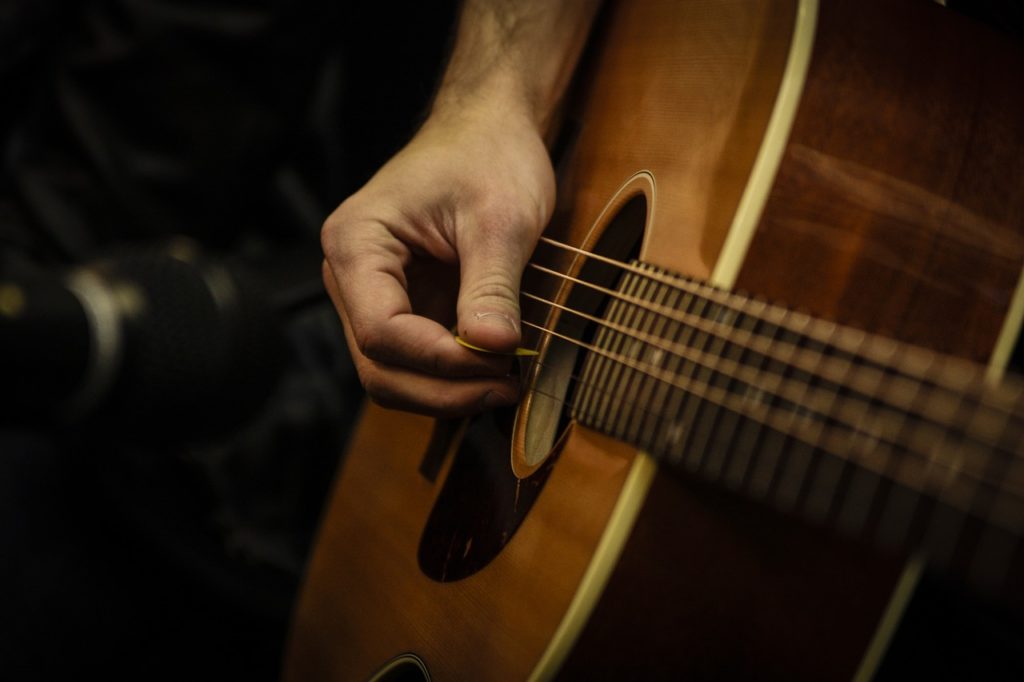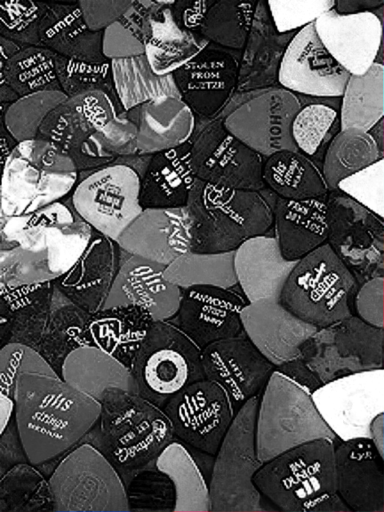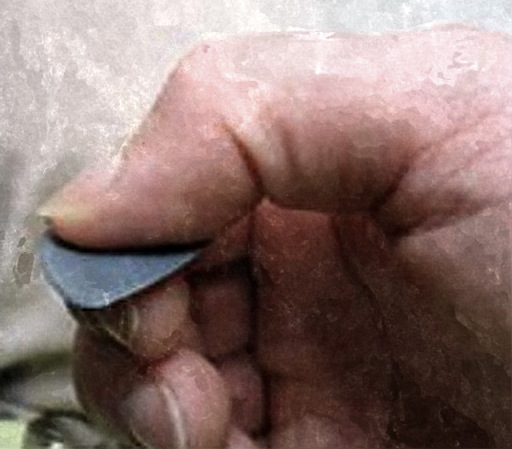Learn Guitar: 10 Tips to Help You Find Your Strumming Groove
Author: Wanda Waterman


Learn Guitar Strumming– that simple up-and-down stroke you make across the strings of your guitar, usually with a flatpick– is a guitar technique that’s easy to do but hard to do well. Not to worry! Helping you learn to play the guitar well, is what we at Uberchord are here for. We have introduced world’s first interactive strumming trainer to train your right-hand technique.
Strumming can be reduced to two basic elements: chords and rhythm. Other elements come into play as well, but chords and rhythm are what make a strum a strum.
The flashy soloist may look like the star of the show, but the strummer is the one who makes it shine. Strummers work with drummers to carry the rhythm of the music, and if there’s no drummer, strummers can produce the needed rhythm– and ambience– all by themselves. Strumming is so much a part of rock, pop, country, and folk music that we hear guitars strummed more often than single-string picked, making it an indispensable part of the guitarist’s arsenal of techniques.
So grab your guitar and your Uberchord app’s inbuilt strumming trainer and get busy! Here are just a few hints:
Table of Contents
1. Get some picks.

Unless you want to strum with your bare thumb like Johnny Cash and a few others, you’ll need flat picks. They’re called flat picks to distinguish them from the kinds of picks that grip your thumb or fingers. You could use a thumb pick to strum, but such picks don’t have a lot of giving, which you’ll need for a good strum sound, so we’ll assume you’ll at least try to learn to strum with a flat pick.
If you haven’t already, buy some picks of varying thicknesses. When you get them home and play with them for a while you’ll eventually settle on the one that feels the most comfortable and gives you the sound you want. Keep extra picks of that thickness, because you’re sure to lose at least one.
2. Watch other strummers.
Watch good guitar strummers, live or on-screen, and commit their styles to memory so you can try them out yourself later.
3. Pick a song, any song, and play it all the way through.
 Learn the chords of your chosen song with the help of your Uberchord app. Then play the song all the way through without stopping, even if your dog starts howling and your little brother says you suck.
Learn the chords of your chosen song with the help of your Uberchord app. Then play the song all the way through without stopping, even if your dog starts howling and your little brother says you suck.
4. Now stop for a bit and experiment with the sound.
At which spot do you flay those strings? On an acoustic guitar, you’ll intuitively tend to strike the strings over the soundhole to get the fullest sound, but you’ll actually need to move back and forth between the soundhole and the bridge until you find the sweet spot. It’s essential to slow down and be mindful for this.
Practice upstrokes. Practice downstrokes. Practice upstrokes and downstrokes. Again, be mindful, little grasshopper. And don’t make any of the strings of the chord jealous; give each one equal attention.
As soon as you’ve played through the song at least once, use your Uberchord app to tell you what string you’re not hitting right, which ones you shouldn’t be hitting at all, and whether you’re chording correctly.
5. Hold the pick right.
 It’s important to hold the pick in a way that allows it to bend a little but also keeps it from flying out of your hand. Most players hold it between the thumb and the side of the forefinger, like in the picture.
It’s important to hold the pick in a way that allows it to bend a little but also keeps it from flying out of your hand. Most players hold it between the thumb and the side of the forefinger, like in the picture.
There’s a product called “Gorilla Snot,” a light adhesive that temporarily glues the pick to your fingers. If you think you need it and can use it without getting grossed out by the name, feel free.
6. Let your guitar breathe.
Don’t clutch your guitar so tight that the sound can’t move through it. Also, position your right arm and hand so they don’t deaden the strings.
7. What to do with that right arm?
Watch Keith Richards’s strumming technique on “Angie.”
Strumming depends more on the movement of your right arm than do single-string flat-picking and fingerpicking. You have to be able to strum rapidly and accurately, keeping good time, either consistent with yourself or with the band.
Having said that, there’s way too much controversy about whether to strum from the elbow or the wrist. In my experience strumming involves a balance of both, but this is your learning curve, so watch the players in these videos and come up with your own style.
Jon Bon Jovi used not only his wrist and elbow but also his shoulder for strumming.
If the chord diagram shows muted strings (you’ll see an “x” over the string), try to mute them with your left thumb in order to avoid letting the pick sound them out. If you find it hard at first to hit all the strings, strum them very, very slowly, speeding up as your sound improves. (For many years jazz musicians have used the slowpoke method to master difficult passages and to improve the sound of their playing. You too can benefit immensely from this trick.)
8. Learn some basic rhythms and practice them.
Essentially strumming involves strumming up, strumming down, and strumming up and down– along with a beat. If you want to learn different rhythms you can find a host of rhythm patterns online just by doing a Google search, but don’t get too hung up on sticking to precise patterns; strumming is a freeform technique that shouldn’t be nailed down. It’s better to find your own groove and roll with it.
9. Learn how to dampen strings.
Even as a beginner you can learn this; it’s not so hard, and besides, it’s a fun thing to play. It means that for a split second you don’t hold your chord down as hard with the left hand. This results in a sound that holds off the guitar’s resonance while creating a crisper beat.
While strumming a chord like F that requires you to hold down most of the strings, try “pulsing” your left hand: Hold down the strings and repeatedly lift your fingers just enough that the strings don’t sound when struck. Do this along with the beat and enjoy the sound it makes. (You can dampen the strings with your right hand as well, but that’s a trickier lesson we’ll leave for later.)
Listen to how Darius Rucker uses string dampening (hear that boom-chik that starts at 1:45?) to add oomph to his rhythm.
10. Get excited!
More than any other guitar technique, good strumming depends on enthusiasm. Enthusiasm is important to single-string flat-picking and fingerpicking as well, but there’s something about the simplicity and immediacy of strumming that enthusiasm really brings to life.
Here’s an experiment for you: Once you’ve roughly learned how to strum your song, record yourself playing it. Now put the guitar down, slap on the headphones, and listen to your favorite rouser– that one song that always revs your motor and gets you to the mountaintop. Now pour that energy into your guitar and record the song again. Hear the difference? That’s enthusiasm.
The Beatles must have been enthusiastic about letting her know money couldn’t buy love:
Here are 5 Essential Strumming Patterns you must learn.
_______
As you become more advanced you can learn more complex rhythms. You can move on to jazz comping, which is a lot harder than it looks! You can also learn to pick individual strings while strumming. But always remember: Enthusiasm and mindfulness are how you find—and keep– your strumming groove!
If you’re interested in practicing your strumming on new songs then we’ve got lots of free lessons here on the blog. Our topics range from beginner lessons to music theory to lead guitar and much more! A few articles we suggest to get you started include maroon 5 chords, the gbmaj chord, and peter frampton chords.








Hey there, You have performed an incredible job. I’ll certainly digg it and in my view recommend to my friends. I am confident they will be benefited from this web site.|
Thank you so much!
A great post without any doubt.